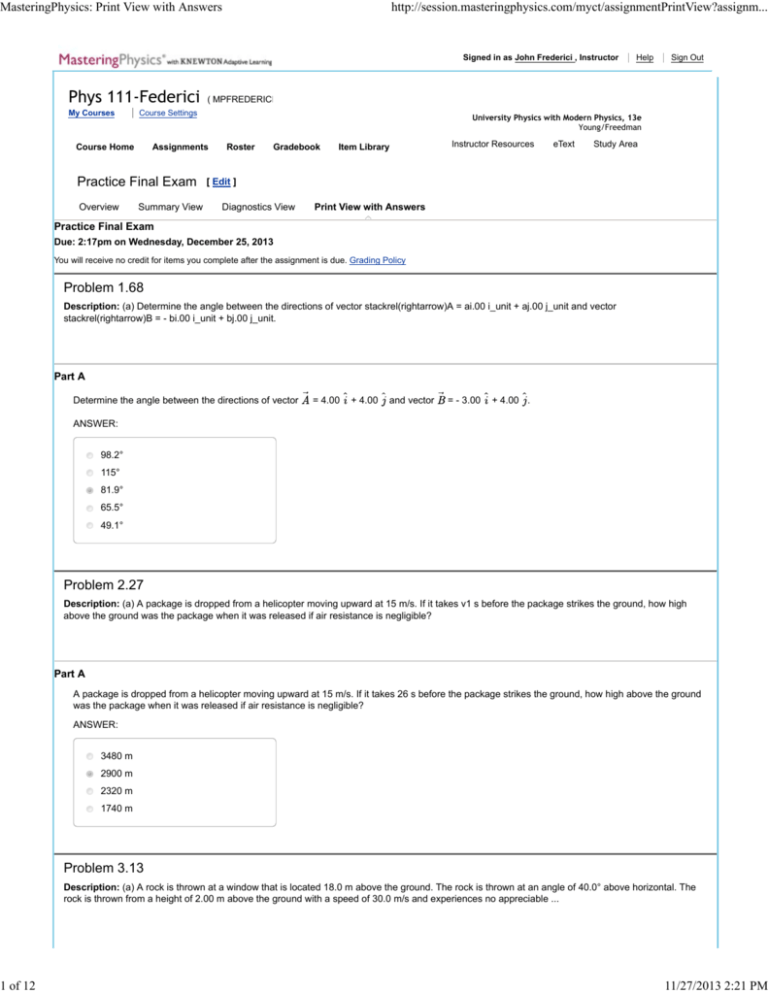
MasteringPhysics: Print View with Answers
1 of 12
http://session.masteringphysics.com/myct/assignmentPrintView?assignm...
Signed in as John Frederici , Instructor
Phys 111-Federici
My Courses
Overview
University Physics with Modern Physics, 13e
Young/Freedman
Assignments
Practice Final Exam
Summary View
Sign Out
( MPFREDERICI31176 )
Course Settings
Course Home
Help
Roster
Gradebook
Item Library
Instructor Resources
eText
Study Area
[ Edit ]
Diagnostics View
Print View with Answers
Practice Final Exam
Due: 2:17pm on Wednesday, December 25, 2013
You will receive no credit for items you complete after the assignment is due. Grading Policy
Problem 1.68
Description: (a) Determine the angle between the directions of vector stackrel(rightarrow)A = ai.00 i_unit + aj.00 j_unit and vector
stackrel(rightarrow)B = - bi.00 i_unit + bj.00 j_unit.
Part A
Determine the angle between the directions of vector
= 4.00
+ 4.00
and vector
= - 3.00
+ 4.00 .
ANSWER:
98.2°
115°
81.9°
65.5°
49.1°
Problem 2.27
Description: (a) A package is dropped from a helicopter moving upward at 15 m/s. If it takes v1 s before the package strikes the ground, how high
above the ground was the package when it was released if air resistance is negligible?
Part A
A package is dropped from a helicopter moving upward at 15 m/s. If it takes 26 s before the package strikes the ground, how high above the ground
was the package when it was released if air resistance is negligible?
ANSWER:
3480 m
2900 m
2320 m
1740 m
Problem 3.13
Description: (a) A rock is thrown at a window that is located 18.0 m above the ground. The rock is thrown at an angle of 40.0° above horizontal. The
rock is thrown from a height of 2.00 m above the ground with a speed of 30.0 m/s and experiences no appreciable ...
11/27/2013 2:21 PM
MasteringPhysics: Print View with Answers
2 of 12
http://session.masteringphysics.com/myct/assignmentPrintView?assignm...
Part A
A rock is thrown at a window that is located 18.0 m above the ground. The rock is thrown at an angle of 40.0° above horizontal. The rock is thrown from
a height of 2.00 m above the ground with a speed of 30.0 m/s and experiences no appreciable air resistance. If the rock strikes the window on its
upward trajectory, from what horizontal distance from the window was it released?
ANSWER:
53.2 m
27.3 m
71.6 m
29.8 m
48.7 m
Problem 3.03
Description: (a) An object has a position given by (r_vec) = (2.0 m + (v1.00 (m/s))t) (i_unit) + (3.0 m - (v2.00 (m/s)^2)t^2) (j_unit), where all quantities
are in SI units. What is the magnitude of the acceleration of the object at time t = 2.00 s?
Part A
An object has a position given by
magnitude of the acceleration of the object at time
, where all quantities are in SI units. What is the
= 2.00 s?
ANSWER:
4.80 m/s
2
3.00 m/s
2
7.20 m/s
2
0.00 m/s
2
6.00 m/s
2
Problem 4.16
Description: (a) A box of mass v1 kg is at rest on a horizontal frictionless surface. A constant horizontal force F then acts on the box and accelerates it
to the right. It is observed that it takes the box v2 seconds to travel v3 meters. What is the magnitude...
Part A
A box of mass 46 kg is at rest on a horizontal frictionless surface. A constant horizontal force F then acts on the box and accelerates it to the right. It is
observed that it takes the box 8 seconds to travel 54 meters. What is the magnitude of the force?
Express your answer using two significant figures.
ANSWER:
F=
= 78 N
Problem 4.21
Description: (a) A series of weights connected by very light cords are given an upward acceleration of 4.00 m/s2 by a pull P, as shown in the figure. A,
B, and C are the tensions in the connecting cords. The SMALLEST of the three tensions, A, B, and C, is...
Part A
11/27/2013 2:21 PM
MasteringPhysics: Print View with Answers
3 of 12
http://session.masteringphysics.com/myct/assignmentPrintView?assignm...
2
A series of weights connected by very light cords are given an upward acceleration of 4.00 m/s by a pull
the tensions in the connecting cords. The SMALLEST of the three tensions, , , and , is closest to
, as shown in the figure.
,
, and
are
ANSWER:
196 N.
276 N.
621 N.
80.0 N.
483 N.
Problem 5.14
Description: (a) A system comprising blocks, a light frictionless pulley, a frictionless incline, and connecting ropes is shown in the figure. The 9.0-kg
block accelerates downward when the system is released from rest. The tension in the rope connecting the...
Part A
A system comprising blocks, a light frictionless pulley, a frictionless incline, and connecting ropes is shown in the figure. The 9.0-kg block accelerates
downward when the system is released from rest. The tension in the rope connecting the 6.0-kg block and the 4.0-kg block is closest to
ANSWER:
42 N.
36 N.
33 N.
30 N.
39 N.
11/27/2013 2:21 PM
MasteringPhysics: Print View with Answers
4 of 12
http://session.masteringphysics.com/myct/assignmentPrintView?assignm...
Problem 5.16
Description: (a) A 4.00-kg block rests between the floor and a 3.00-kg block as shown in the figure. The 3.00-kg block is tied to a wall by a horizontal
rope. If the coefficient of static friction is 0.800 between each pair of surfaces in contact, what...
Part A
A 4.00-kg block rests between the floor and a 3.00-kg block as shown in the figure. The 3.00-kg block is tied to a wall by a horizontal rope. If the
coefficient of static friction is 0.800 between each pair of surfaces in contact, what horizontal force must be applied to the 4.00-kg block to make it
move?
ANSWER:
16.2 N
23.5 N
21.1 N
78.4 N
54.9 N
Problem 5.57
Description: (a) A car enters a 300-m radius horizontal curve on a rainy day when the coefficient of static friction between its tires and the road is
0.600. What is the maximum speed at which the car can travel around this curve without sliding?
Part A
A car enters a 300-m radius horizontal curve on a rainy day when the coefficient of static friction between its tires and the road is 0.600. What is the
maximum speed at which the car can travel around this curve without sliding?
ANSWER:
42.0 m/s
37.9 m/s
33.1 m/s
29.6 m/s
24.8 m/s
Problem 6.35
Description: (a) A m-kg mass is attached to a very light ideal spring hanging vertically and hangs at rest in the equilibrium position. The spring
constant of the spring is 1.00 N/cm. The mass is pulled downward 2.00 cm and released. What is the speed of the...
Part A
A 7.00-kg mass is attached to a very light ideal spring hanging vertically and hangs at rest in the equilibrium position. The spring constant of the spring
is 1.00 N/cm. The mass is pulled downward 2.00 cm and released. What is the speed of the mass when it is 1.00 cm above the point from which it was
11/27/2013 2:21 PM
MasteringPhysics: Print View with Answers
5 of 12
http://session.masteringphysics.com/myct/assignmentPrintView?assignm...
released?
ANSWER:
0.0655 m/s
0.0786 m/s
0.1047 m/s
0.0917 m/s
The mass will not reach the height specified.
Problem 6.31
Description: (a) In the figure, a v5-kg crate is on a rough surface inclined at 30°. A constant external force P = v6 N is applied horizontally to the crate.
While this force pushes the crate a distance of 3.0 m up the incline, its velocity changes from v1 m/s...
Part A
In the figure, a 800-kg crate is on a rough surface inclined at 30°. A constant external force P = 6400 N is applied horizontally to the crate. While this
force pushes the crate a distance of 3.0 m up the incline, its velocity changes from 1.1 m/s to 2.1 m/s. How much work does friction do during this
process?
ANSWER:
-6100 J
+3600 J
-3600 J
+6100 J
zero
Problem 7.31
Description: (a) A v2-kg block is held in place against the spring by a v1-N horizontal external force (see the figure). The external force is removed,
and the block is projected with a velocity v 1 = 1.2 m/s upon separation from the spring. The block...
Part A
A 1.4-kg block is held in place against the spring by a 28-N horizontal external force (see the figure). The external force is removed, and the block is
projected with a velocity v 1 = 1.2 m/s upon separation from the spring. The block descends a ramp and has a velocity v 2 = 2.1 m/s at the bottom. The
track is frictionless between points A and B. The block enters a rough section at B, extending to E. The coefficient of kinetic friction over this section is
0.33. The velocity of the block is v 3 = 1.4 m/s at C. The block moves on to D, where it stops. The height h of the ramp is closest to
11/27/2013 2:21 PM
MasteringPhysics: Print View with Answers
6 of 12
http://session.masteringphysics.com/myct/assignmentPrintView?assignm...
ANSWER:
19
21
15
22
7.3
Problem 7.27
Description: (a) In the figure, a block of mass m is moving along the horizontal frictionless surface with a speed of 5.70 m/s. If the slope is 11.0° and
the coefficient of kinetic friction between the block and the incline is 0.260, how far does the block...
Part A
In the figure, a block of mass
is moving along the horizontal frictionless surface with a speed of 5.70 m/s. If the slope is 11.0° and the coefficient of
kinetic friction between the block and the incline is 0.260, how far does the block travel up the incline?
ANSWER:
m
Problem 8.29
Description: (a) A 1.2-kg spring-activated toy bomb slides on a smooth surface along the x-axis with a speed of 0.50 m/s. At the origin 0, the bomb
explodes into two fragments. Fragment 1 has a mass of 0.40 kg and a speed of 0.90 m/s along the negative y-axis...
Part A
A 1.2-kg spring-activated toy bomb slides on a smooth surface along the -axis with a speed of 0.50 m/s. At the origin , the bomb explodes into two
fragments. Fragment 1 has a mass of 0.40 kg and a speed of 0.90 m/s along the negative -axis. In the figure, the angle , made by the velocity vector
of fragment 2 and the -axis, is closest to
ANSWER:
11/27/2013 2:21 PM
MasteringPhysics: Print View with Answers
7 of 12
http://session.masteringphysics.com/myct/assignmentPrintView?assignm...
38 .
37 .
59 .
31 .
53 .
Problem 8.34
Description: (a) In the figure, four point masses are placed as shown. The x and y coordinates of the center of mass are closest to...
Part A
In the figure, four point masses are placed as shown. The x and y coordinates of the center of mass are closest to
ANSWER:
(2.2 m, 2.6 m).
(2.3 m, 2.7 m).
(2.2 m, 2.7 m).
(2.3 m, 2.8 m).
(2.3 m, 2.6 m).
Problem 9.12
Description: (a) A piece of thin uniform wire of mass m and length 3b is bent into an equilateral triangle. Find the moment of inertia of the wire triangle
about an axis perpendicular to the plane of the triangle and passing through one of its vertices.
Part A
A piece of thin uniform wire of mass
and length 3 is bent into an equilateral triangle. Find the moment of inertia of the wire triangle about an axis
perpendicular to the plane of the triangle and passing through one of its vertices.
ANSWER:
2
mb
2
mb
2
mb
2
mb
2
mb
11/27/2013 2:21 PM
MasteringPhysics: Print View with Answers
8 of 12
http://session.masteringphysics.com/myct/assignmentPrintView?assignm...
Problem 9.11
Description: (a) A 1.25-kg ball begins rolling from rest with constant angular acceleration down a hill. If it takes 3.60 s for it to make the first complete
revolution, how long will it take to make the next complete revolution?
Part A
A 1.25-kg ball begins rolling from rest with constant angular acceleration down a hill. If it takes 3.60 s for it to make the first complete revolution, how
long will it take to make the next complete revolution?
ANSWER:
1.49 s
Problem 10.15
Description: (a) A wheel has a radius of 0.40 m and is mounted on frictionless bearings. A block is suspended from a rope that is wound on the wheel
and attached to it (see figure). The wheel is released from rest and the block descends 1.5 m in 2.00 s without...
Part A
A wheel has a radius of 0.40 m and is mounted on frictionless bearings. A block is suspended from a rope that is wound on the wheel and attached to it
(see figure). The wheel is released from rest and the block descends 1.5 m in 2.00 s without any slipping of the rope. The tension in the rope during the
descent of the block is 20 N. What is the moment of inertia of the wheel?
ANSWER:
2
3.5 kg · m
2
4.3 kg · m
2
3.9 kg · m
2
3.7 kg · m
2
4.1 kg · m
Problem 10.25
Description: (a) A uniform solid sphere is rolling without slipping along a horizontal surface with a speed of v m/s when it starts up a ramp that makes
an angle of 25.0° with the horizontal. What is the speed of the sphere after it has rolled 3.00 m up the...
Part A
A uniform solid sphere is rolling without slipping along a horizontal surface with a speed of 5.30 m/s when it starts up a ramp that makes an angle of
25.0° with the horizontal. What is the speed of the sphere after it has rolled 3.00 m up the ramp, measured along the surface of the ramp?
ANSWER:
11/27/2013 2:21 PM
MasteringPhysics: Print View with Answers
9 of 12
http://session.masteringphysics.com/myct/assignmentPrintView?assignm...
5.14 m/s
4.50 m/s
3.86 m/s
2.57 m/s
3.21 m/s
Problem 11.21
Description: (a) In the figure, a 10.0-m long bar is attached by a frictionless hinge to a wall and held horizontal by a rope that makes an angle theta of
53° with the bar. The bar is uniform and weighs 39.9 N. How far from the hinge should a 10.0-kg mass be...
Part A
In the figure, a 10.0-m long bar is attached by a frictionless hinge to a wall and held horizontal by a rope that makes an angle of 53° with the bar. The
bar is uniform and weighs 39.9 N. How far from the hinge should a 10.0-kg mass be suspended for the tension in the rope to be 125 N?
ANSWER:
8.15 m from the hinge
Problem 11.16
Description: (a) A 10.0-kg uniform ladder that is 2.50 m long is placed against a smooth vertical wall and reaches to a height of 2.10 m, as shown in
the figure. The base of the ladder rests on a rough horizontal floor whose coefficient of static friction with...
Part A
A 10.0-kg uniform ladder that is 2.50 m long is placed against a smooth vertical wall and reaches to a height of 2.10 m, as shown in the figure. The
base of the ladder rests on a rough horizontal floor whose coefficient of static friction with the ladder is 0.800. An 80.0-kg bucket of concrete is
suspended from the top rung of the ladder, right next to the wall, as shown in the figure. What is the magnitude of the friction force that the floor exerts
on the ladder?
11/27/2013 2:21 PM
MasteringPhysics: Print View with Answers
10 of 12
http://session.masteringphysics.com/myct/assignmentPrintView?assignm...
ANSWER:
601 N
538 N
1290 N
706 N
833 N
Problem 12.35
Description: (a) Water flows in the horizontal pipe shown in the figure. At point A the area is 25.0 cm2 and the speed of the water is 2.00 m/s. At B the
area is 16.0 cm2. The fluid in the manometer is mercury, which has a density of 13,600 kg/m3. We can treat...
Part A
Water flows in the horizontal pipe shown in the figure. At point
2
2
the area is 25.0 cm and the speed of the water is 2.00 m/s. At
the area is 16.0
3
3
cm . The fluid in the manometer is mercury, which has a density of 13,600 kg/m . We can treat water as an ideal fluid having a density of 1000 kg/m .
What is the manometer reading ?
ANSWER:
2.16 cm
1.31 cm
0.546 cm
2.81 cm
3.36 cm
Problem 12.34
Description: (a) In a section of horizontal pipe with a diameter of 3.00 cm the pressure is 5.21 kPa and water is flowing with a speed of 1.50 m/s. The
pipe narrows to 2.50 cm. What is the pressure in the narrower region if water behaves like an ideal fluid of...
Part A
11/27/2013 2:21 PM
MasteringPhysics: Print View with Answers
11 of 12
http://session.masteringphysics.com/myct/assignmentPrintView?assignm...
In a section of horizontal pipe with a diameter of 3.00 cm the pressure is 5.21 kPa and water is flowing with a speed of 1.50 m/s. The pipe narrows to
3
2.50 cm. What is the pressure in the narrower region if water behaves like an ideal fluid of density 1000 kg/m ?
ANSWER:
5.82 kPa
4.00 kPa
4.61 kPa
6.42 kPa
7.50 kPa
Problem 13.15
Description: (a) A huge cannon is assembled on an airless planet having insignificant axial spin. The planet has a radius of 5.00 × 106 m and a mass
of v1 × 1023 kg. The cannon fires a projectile straight up at 2000 m/s. An observation satellite orbits the...
Part A
6
23
A huge cannon is assembled on an airless planet having insignificant axial spin. The planet has a radius of 5.00 × 10 m and a mass of 2.16 × 10 kg.
The cannon fires a projectile straight up at 2000 m/s. An observation satellite orbits the planet at a height of 1000 km. What is the projectile's speed as
-11
it passes the satellite? (G= 6.67 × 10
2
2
N · m /kg )
ANSWER:
1800 m/s
1690 m/s
1640 m/s
1740 m/s
Problem 13.02
Description: (a) An astronaut is in equilibrium when he is positioned v1 km from the center of asteroid X and v2 km from the center of asteroid Y, along
the straight line joining the centers of the asteroids. What is the ratio of the masses X/Y of the asteroids?
Part A
An astronaut is in equilibrium when he is positioned 571 km from the center of asteroid X and 735 km from the center of asteroid Y, along the straight
line joining the centers of the asteroids. What is the ratio of the masses X/Y of the asteroids?
ANSWER:
1.66
0.604
0.777
1.29
Problem 14.12
Description: (a) A 2.0 kg block on a frictionless table is connected to two ideal massless springs with spring constants k 1 and k 2 whose opposite
ends are fixed to walls, as shown in the figure. What is angular frequency of the oscillation if k1= v1...
Part A
A 2.0 kg block on a frictionless table is connected to two ideal massless springs with spring constants k 1 and k 2 whose opposite ends are fixed to
11/27/2013 2:21 PM
MasteringPhysics: Print View with Answers
12 of 12
http://session.masteringphysics.com/myct/assignmentPrintView?assignm...
walls, as shown in the figure. What is angular frequency of the oscillation if k1=
N/m and k2= 5 N/m?
ANSWER:
2.7 rad/s
0.43 rad/s
1.9 rad/s
0.31 rad/s
Problem 14.05
Description: (a) A machine part is vibrating along the x-axis in simple harmonic motion with a period of 0.27 s and a range (from the maximum in one
direction to the maximum in the other) of 3.0 cm. At time t = 0 it is at its central position and moving in the...
Part A
A machine part is vibrating along the x-axis in simple harmonic motion with a period of 0.27 s and a range (from the maximum in one direction to the
maximum in the other) of 3.0 cm. At time = 0 it is at its central position and moving in the + direction. What is its position when = 55 s?
ANSWER:
= +0.51 cm
= -1.4 cm
= -0.43 cm
= -1.3 cm
= -0.51 cm
Copyright © 2013 Pearson. All rights reserved.
Legal Notice
Privacy Policy
Permissions
Support
11/27/2013 2:21 PM


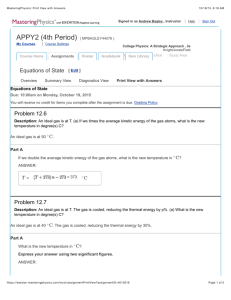
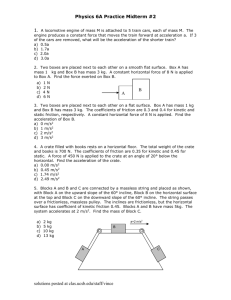
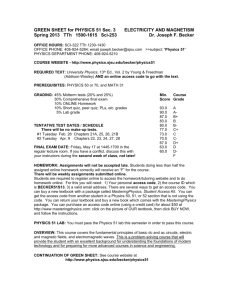

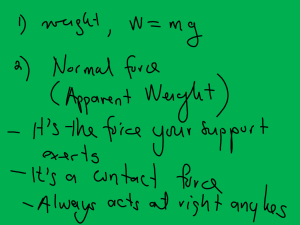
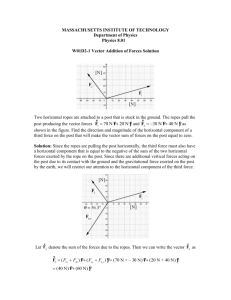
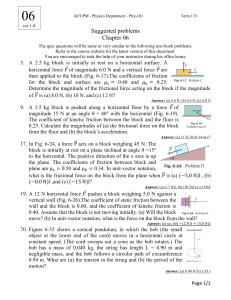
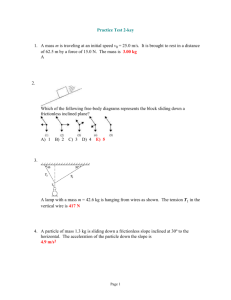
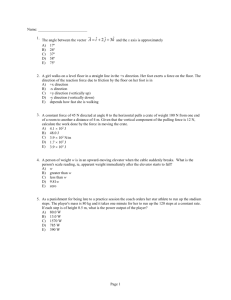

![Exercise 14.2 Exercise 14.7 Week 13: Chapter 14 [ Edit ]](http://s3.studylib.net/store/data/008705527_1-add416cf87c7140418a6211e7e753c1a-300x300.png)